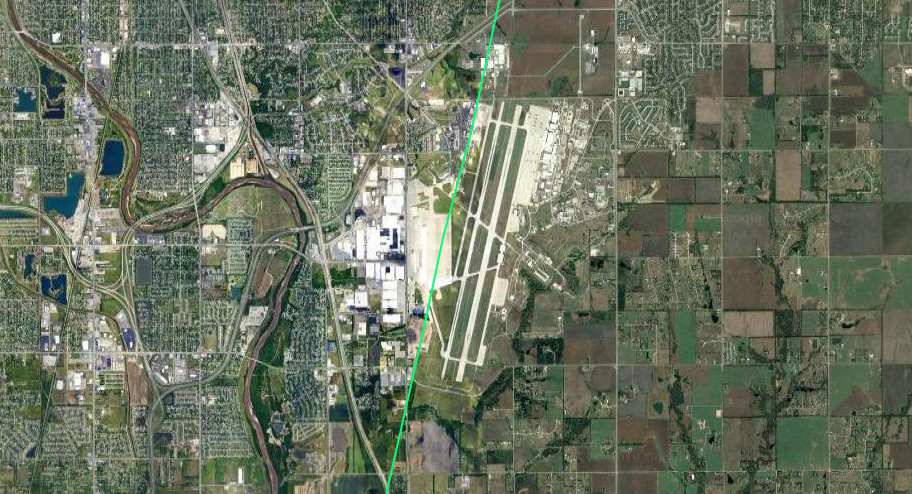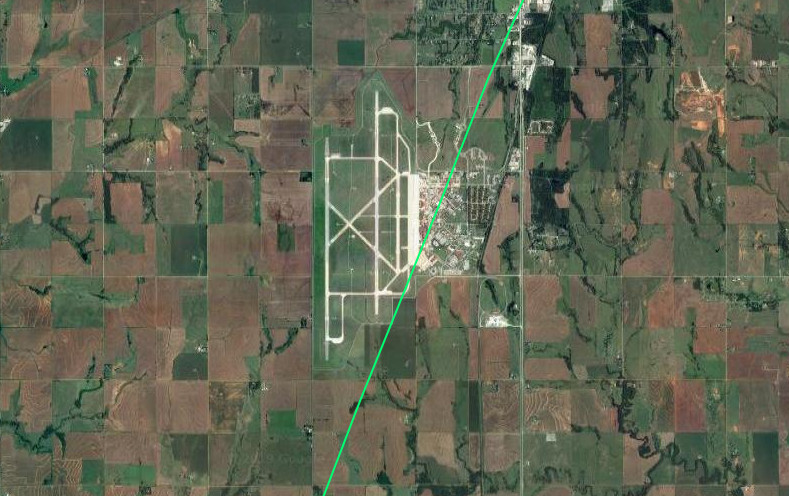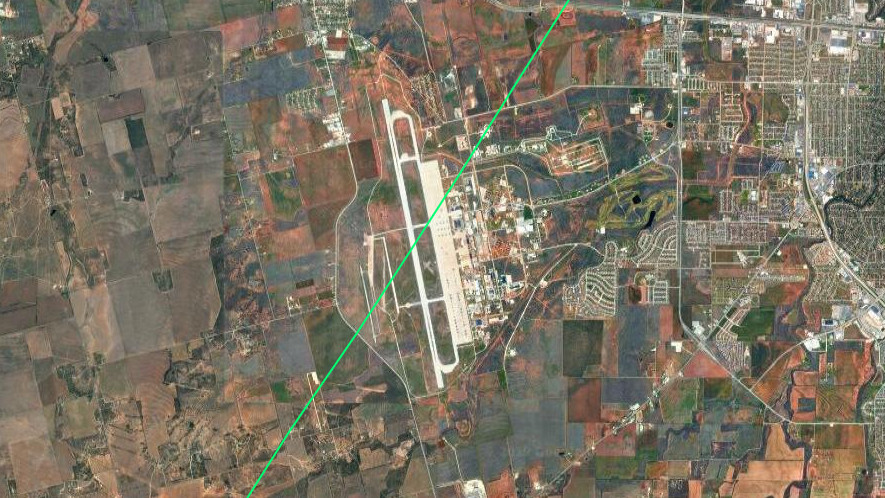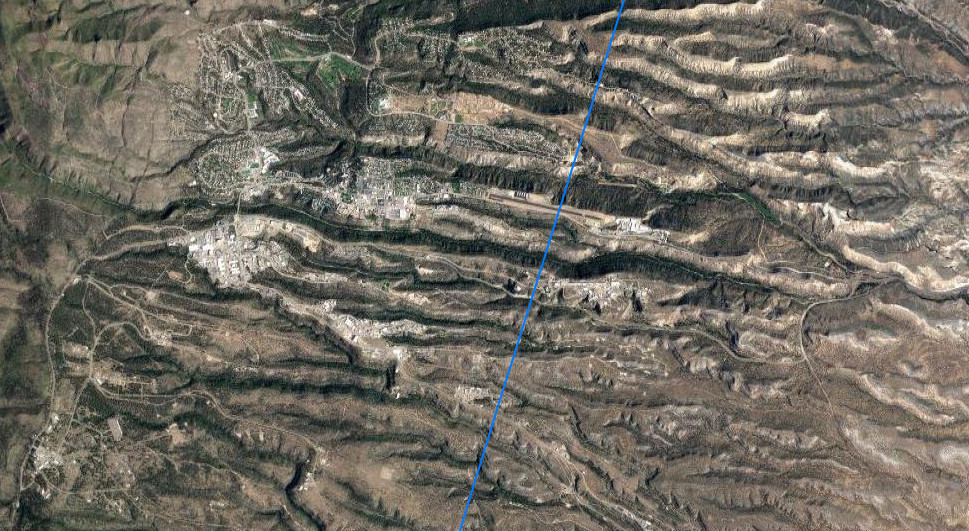One Russia’s two Tu-214ON aircraft has conducted what appears to be its first-ever flight over the United States under the Open Skies Treaty. This agreement allows member states to conduct aerial surveillance missions, with certain limitations in hardware and in the presence of monitors from the surveilled country, over each other’s territory. Today’s sortie took the Russian plane over parts of West Texas, through New Mexico, and into Colorado, including overflights of Fort Bliss, White Sands Missile Range, Sandia and Los Alamos National Laboratories, and finally hitting up the Pueblo Chemical Depot.
The Tu-214ON, with the registration number RF-64525, took off from Rosecrans Air National Guard Base in Saint Joseph, Missouri, at around 1:50 PM local time on Apr. 25, 2019. The aircraft arrived at Rosecrans three days earlier and the Russian Ministry of Defense says it will continue flying from the base in Missouri until Apr. 27, 2019.
After leaving Rosecrans, the modified airliner flew a relatively straightforward route south at a constant speed of around 270 knots, or 310 miles per hour, and at altitudes between 5,000 and 7,000 feet. The flight path through Kansas, Oklahoma, and into Texas took the plane over a number of major U.S. military installations, including the U.S. Army’s Fort Riley and the U.S. Air Force’s McConnell Air Force Base, both in Kansas, Vance Air Force Base and Fort Sill in Oklahoma, and Sheppard Air Force Base and Dyess Air Force Base in Texas.






After passing by Dyess, the Tu-214ON turned West. About 150 miles east of El Paso, the plane climbed to an altitude of almost 16,000 feet to begin a medium-altitude surveillance run.

In El Paso, the plane flew over the U.S. Army’s Fort Bliss and its associated Biggs Army airfield, as well as other parts of the base’s extensive reservation. This facility is home to the 1st Armored Division and the 11th Air Defense Artillery Brigade, among other units. The 11th controls the service’s Terminal High Altitude Air Defense (THAAD) ballistic missile defense batteries.


After turning north, the aircraft flew into New Mexico to the expansive White Sands Missile Range. Though Army-managed, White Sands supports a wide array of joint service and other government training and testing activities, including, but certainly not limited to testing new artillery systems and directed energy weapons, evaluating aircraft and aircraft self-defense countermeasures systems, and more. There’s even a mock U.S. Navy ship, known as USS Desert Ship or Land Locked Ship One (LSS-1), where that service can test various maritime systems, including missiles and radars.
Russia’s Tu-214ON flew a route that showed a unique effort to pass over a NASA facility near White Sands, as well as the National Radar Cross Section Test Facility (NRTF). The NRTF is very similar in function and design to Lockheed Martin’s Skunk Works’ Helendale Radar Signature Test Range, which you can read about in more detail here.


After passing through White Sands, the Russian surveillance plane continued up to Albuquerque, New Mexico. This city is home to the Air Force’s Kirtland Air Force Base and Sandia National Laboratories main site. Kirtland is home to two Special Operations Wings, the 58th and 150th, the Air Force Research Laboratory’s (AFRL) Directed Energy and Space Vehicle’s Directorates, the Air Force Nuclear Weapons Center, and variety of other test and evaluation units. Kirtland also serves as a storage site for nuclear weapons. Sandia National Laboratories’ primary work is also in nuclear weapons, though it supports a variety of other research and development efforts, including hypersonic weapons.
Interestingly, AFRL’s Directed Energy Directorate has also been involved in trying to reverse engineer a still unknown weapon blamed for a string of mysterious attacks on U.S. diplomatic staff in Cuba. The U.S. government reportedly has evidence tying the attacks to Russia.
The plane’s route then continued north past Los Alamos National Laboratory, another prominent Department of Energy site that supports nuclear weapons research and other development activities.


After the tour of nuclear sites in New Mexico, the plane continued north in Colorado. Making its way past the city of Pueblo, the plane turned to cross over the Army’s Pueblo Chemical Depot, home of the Chemical Materials Activity, which is responsible for overseeing the elimination of the U.S. military’s remaining chemical weapons stockpile. The Pueblo Chemical Depot is one of only two remaining U.S. Army facilities that store chemical weapons awaiting disposal, the other being the Bluegrass Army Depot in Kentucky.

The Pueblo Chemical Depot was the last stop on the route before the plane climbed up to 30,000 feet to begin its return journey to Rosecrans in Missouri. All told, the route was very similar to one the Russians flew in 2017 using their older Tu-154M-ON Open Skies aircraft.
In 2018, the Open Skies Treaty looked like it might completely collapse over growing disputes between the United States and Russia, as well as a separate spat between the Russians and the Georgians, the latter of which had put a halt to virtually all flights last year. In September 2018, the U.S. government even briefly refused to certify the Tu-214ONs as compliant with the terms of the agreement. You can read more about all of these issues here.
Russia and Georgia eventually resolved the differences and the Tu-214ONs are now certified. As such, 2019 has already seen a steady series of Open Skies flights around the world. Just in March 2019, Russia’s Tu-154M-ON flew a route in the Southwestern United States, including over the secretive Area 51 test site in Nevada.
RF-64525 is set to depart Rosecrans at around 12:30 PM on Apr. 26, 2019 for another mission over areas of Colorado and Nebraska. This could take it over a number of other strategic sites, such as Offutt Air Force Base in Omaha and the Cheyenne Mountain Complex bunker outside Colorado Springs.
The plane is then scheduled to head back to Russia on Apr. 27, 2019, but with Open Skies back in full swing, we could easily be seeing one of the Kremlin’s surveillance planes come back later in the year for another visit.
Contact the author: joe@thedrive.com
